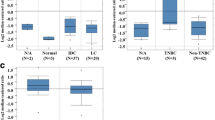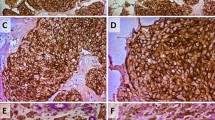Abstract
The concept of cancer cells being hierarchically organized and arising from their own progenitor stem cells will have important implications on cancer therapy. If this hypothesis were to be true then the paucity of estrogen receptors in stem cells as well as their inherent drug resistance mechanisms pose a challenge to current targeted therapies. In this study, we sought to examine the prognostic relevance of ALDH1, a putative cancer stem cell marker, by immunohistochemistry. The four cohorts analyzed included an adjuvantly treated series of 245 invasive cancers, a neoadjuvantly treated series of 34 cases, and two series of 58 and 40 triple negative cases, respectively. Both tumor cell and stromal expression for ALDH1 was evaluated, where possible. Tumor cell ALDH1 expression significantly correlated only with basal-like and HER2 tumor types in the adjuvant series and tumor grade in the neoadjuvant cohort. No significant enrichment for ALDH1 positive cells was observed in the postneoadjuvant therapy specimens compared to pretreatment samples. On the other hand, high degree of stromal expression was significantly associated with best disease-free survival as well as a trend for overall survival. The association of stromal expression was confirmed in an independent cohort of triple negative cases. The novel finding is that tumor microenvironment may play a significant role in determining the prognostic impact of stem/progenitor cells in human breast tumors.





Similar content being viewed by others
References
Cohnheim J (1867) Ueber entzundung und eiterung. Path Anat Physiol Klin Med 40:1–79
Nakshatri H, Srour EF, Badve S (2009) Breast cancer stem cells and intrinsic subtypes: controversies rage on. Curr Stem Cell Res Ther 4:50–60
Polyak K (2007) Breast cancer: origins and evolution. J Clin Invest 117:3155–3163
Visvader JE, Lindeman GJ (2008) Cancer stem cells in solid tumours: accumulating evidence and unresolved questions. Nat Rev Cancer 8:755–768
Hill RP, Perris R (2007) “Destemming” cancer stem cells. J Natl Cancer Inst 99:1435–1440
Clarke MF, Dick JE, Dirks PB, Eaves CJ, Jamieson CH, Jones DL, Visvader J, Weissman IL, Wahl GM (2006) Cancer stem cells—perspectives on current status and future directions: AACR workshop on cancer stem cells. Cancer Res 66:9339–9344
Kakarala M, Wicha MS (2008) Implications of the cancer stem-cell hypothesis for breast cancer prevention and therapy. J Clin Oncol 26:2813–2820
Morrison BJ, Schmidt CW, Lakhani SR, Reynolds BA, Lopez JA (2008) Breast cancer stem cells: implications for therapy of breast cancer. Breast Cancer Res 10:210
Dontu G, Abdallah WM, Foley JM, Jackson KW, Clarke MF, Kawamura MJ, Wicha MS (2003) In vitro propagation and transcriptional profiling of human mammary stem/progenitor cells. Genes Dev 17:1253–1270
Phillips TM, McBride WH, Pajonk F (2006) The response of cd24(−/low)/cd44+ breast cancer-initiating cells to radiation. J Natl Cancer Inst 98:1777–1785
Li X, Lewis MT, Huang J, Gutierrez C, Osborne CK, Wu MF, Hilsenbeck SG, Pavlick A, Zhang X, Chamness GC, Wong H, Rosen J, Chang JC (2008) Intrinsic resistance of tumorigenic breast cancer cells to chemotherapy. J Natl Cancer Inst 100:672–679
O’Brien CS, Farnie G, Howell SJ, Clarke RB (2008) Are stem-like cells responsible for resistance to therapy in breast cancer? Breast Dis 29:83–89
Eyler CE, Rich JN (2008) Survival of the fittest: cancer stem cells in therapeutic resistance and angiogenesis. J Clin Oncol 26:2839–2845
Diehn M, Clarke MF (2006) Cancer stem cells and radiotherapy: new insights into tumor radioresistance. J Natl Cancer Inst 98:1755–1757
Al-Hajj M, Wicha MS, Benito-Hernandez A, Morrison SJ, Clarke MF (2003) Prospective identification of tumorigenic breast cancer cells. Proc Natl Acad Sci USA 100:3983–3988
Sheridan C, Kishimoto H, Fuchs RK, Mehrotra S, Bhat-Nakshatri P, Turner CH, Goulet R Jr, Badve S, Nakshatri H (2006) Cd44+/cd24− breast cancer cells exhibit enhanced invasive properties: an early step necessary for metastasis. Breast Cancer Res 8:R59
Mani SA, Guo W, Liao MJ, Eaton EN, Ayyanan A, Zhou AY, Brooks M, Reinhard F, Zhang CC, Shipitsin M, Campbell LL, Polyak K, Brisken C, Yang J, Weinberg RA (2008) The epithelial-mesenchymal transition generates cells with properties of stem cells. Cell 133:704–715
Honeth G, Bendahl PO, Ringner M, Saal LH, Gruvberger-Saal SK, Lovgren K, Grabau D, Ferno M, Borg A, Hegardt C (2008) The cd44+/cd24− phenotype is enriched in basal-like breast tumors. Breast Cancer Res 10:R53
Xiao Y, Ye Y, Yearsley K, Jones S, Barsky SH (2008) The lymphovascular embolus of inflammatory breast cancer expresses a stem cell-like phenotype. Am J Pathol 173:561–574
Mylona E, Giannopoulou I, Fasomytakis E, Nomikos A, Magkou C, Bakarakos P, Nakopoulou L (2008) The clinicopathologic and prognostic significance of cd44+/cd24(−/low) and cd44−/cd24+ tumor cells in invasive breast carcinomas. Hum Pathol 39:1096–1102
Ginestier C, Hur MH, Charafe-Jauffret E, Monville F, Dutcher J, Brown M, Jacquemier J, Viens P, Kleer CG, Liu S, Schott A, Hayes D, Birnbaum D, Wicha MS, Dontu G (2007) ALDH1 is a marker of normal and malignant human mammary stem cells and a predictor of poor clinical outcome. Cell Stem Cell 1:555–567
Croker AK, Goodale D, Chu J, Postenka C, Hedley BD, Hess DA, Allan AL (2008) High aldehyde dehydrogenase and expression of cancer stem cell markers selects for breast cancer cells with enhanced malignant and metastatic ability. J Cell Mol Med. doi:10.1111/j.1582-4934.2008.00455.x
Neumeister V, Agarwal S, Camp R, Rimm D (2009) In situ characterization of possible cancer stem cells in breast cancer by multiplexing ALDH1, CD44 and cytokeratin on tissue microarrays. Cancer Res 69:102
Tanei T, Morimoto K, Shimazu K, Kim SJ, Tanji Y, Taguchi T, Tamaki Y, Noguchi S (2009) Association of breast cancer stem cells identified by aldehyde dehydrogenase 1 expression with resistance to sequential paclitaxel and epirubicin-based chemotherapy for breast cancers. Clin Cancer Res 15:4234–4241
Kunju LP, Toy K, Thomas D, Ding Y, Kleer CG (2009) Expression of the stem cell markers ALDH1 and EZH2 in triple negative invasive breast carcinomas. [Abstracts of the annual meeting of the united states and canadian academy of pathology. March 7–13, 2009. Boston, Massachusetts, USA]. Lab Invest 89(Suppl 1):52A
Korkaya H, Paulson A, Iovino F, Wicha MS (2008) HER2 regulates the mammary stem/progenitor cell population driving tumorigenesis and invasion. Oncogene 27:6120–6130
Arriola E, Rodriguez-Pinilla SM, Lambros MB, Jones RL, James M, Savage K, Smith IE, Dowsett M, Reis-Filho JS (2007) Topoisomerase ii alpha amplification may predict benefit from adjuvant anthracyclines in HER2 positive early breast cancer. Breast Cancer Res Treat 106:181–189
Tan DS, Marchio C, Jones RL, Savage K, Smith IE, Dowsett M, Reis-Filho JS (2008) Triple negative breast cancer: molecular profiling and prognostic impact in adjuvant anthracycline-treated patients. Breast Cancer Res Treat 111:27–44
Nielsen TO, Hsu FD, Jensen K, Cheang M, Karaca G, Hu Z, Hernandez-Boussard T, Livasy C, Cowan D, Dressler L, Akslen LA, Ragaz J, Gown AM, Gilks CB, van de Rijn M, Perou CM (2004) Immunohistochemical and clinical characterization of the basal-like subtype of invasive breast carcinoma. Clin Cancer Res 10:5367–5374
Bhargava R, Beriwal S, McManus K, Dabbs D (2009) ALDH1 expression in human breast carcinoma. Cancer Res 69:5057
Charafe-Jauffret E, Ginestier C, Iovino F, Wicinski J, Cervera N, Finetti P, Hur MH, Diebel ME, Monville F, Dutcher J, Brown M, Viens P, Xerri L, Bertucci F, Stassi G, Dontu G, Birnbaum D, Wicha MS (2009) Breast cancer cell lines contain functional cancer stem cells with metastatic capacity and a distinct molecular signature. Cancer Res 69:1302–1313
Sarrio D, Rodriguez-Pinilla SM, Hardisson D, Cano A, Moreno-Bueno G, Palacios J (2008) Epithelial-mesenchymal transition in breast cancer relates to the basal-like phenotype. Cancer Res 68:989–997
Press MF, Finn RS, Di Leo A, Cameron DA, Geyer CE, Martin A, Newstat B, Arbushites M, Koehler M (2008) Correlation of HER2 gene amplification, HER2 and EGFR expression (protein and mRNA) with lapatinib efficacy in women with metastatic breast cancer. J Clin Oncol 26:42S
Resetkova E, Thorat MA, Badve S (2008) Expression of ALDH1 (putative stem cell marker) does not correlate with response to neo-adjuvant chemotherapy (NACT) in breast carcinoma. [Abstracts of the XXVIIth international congress of the international academy of pathology. October 12–17, 2008. Athens, Greece]. Histopathology 53(Abst 133):159
Lim E, Vaillant F, Wu D, Forrest NC, Pal B, Hart AH, Asselin-Labat ML, Gyorki DE, Ward T, Partanen A, Feleppa F, Huschtscha LI, Thorne HJ, Fox SB, Yan M, French JD, Brown MA, Smyth GK, Visvader JE, Lindeman GJ (2009) Aberrant luminal progenitors as the candidate target population for basal tumor development in BRCA1 mutation carriers. Nat Med 15:907–913
Yoshida A, Hsu LC, Dave V (1992) Retinal oxidation activity and biological role of human cytosolic aldehyde dehydrogenase. Enzyme 46:239–244
Yang Q, Sakurai T, Kakudo K (2002) Retinoid, retinoic acid receptor beta and breast cancer. Breast Cancer Res Treat 76:167–173
Author information
Authors and Affiliations
Corresponding author
Additional information
Erika Resetkova and Jorge S. Reis-Filho contributed equally to the present study.
Rights and permissions
About this article
Cite this article
Resetkova, E., Reis-Filho, J.S., Jain, R.K. et al. Prognostic impact of ALDH1 in breast cancer: a story of stem cells and tumor microenvironment. Breast Cancer Res Treat 123, 97–108 (2010). https://doi.org/10.1007/s10549-009-0619-3
Received:
Accepted:
Published:
Issue Date:
DOI: https://doi.org/10.1007/s10549-009-0619-3




